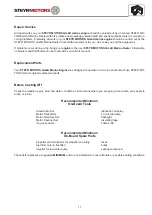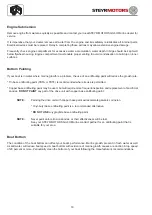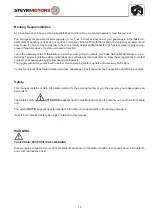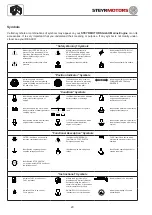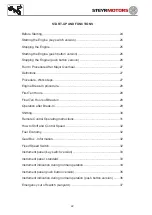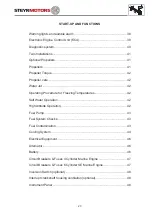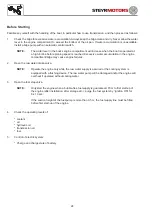
9
All fuels and many chemical substances are flammable. Do not allow naked flame or sparks in the vicin-
ity. Fuel, certain thinner products and hydrogen from batteries can be extremely flammable and explosive
when mixed with air.
Smoking is not to be permitted in the vicinity!
Ensure that the work area is well ventilated and take the necessary safety precautions before starting
welding or grinding work. Always ensure that there are fire extinguishers at hand when work is being car-
ried out.
Ensure that rags soaked in oil or fuel and used fuel or oil filters are stored safely. Rags soaked in oil can
spontaneously ignite under certain circumstances. Used fuel and oil filters are environmentally danger-
ous waste and must be deposited at an approved site for destruction together with used lubricating oil,
contaminated fuel, paint remnants, solvent, degreasing agents and waste from washing parts.
Never expose a battery to naked flame or electrical sparks. Never smoke in proximity to the batteries.
The batteries give off hydrogen gas during charging which when mixed with air can form an explosive gas
-oxyhydrogen. This gas is easily ignited and highly volatile. Incorrect connection of the battery can cause
a single spark which is sufficient to cause an explosion with resulting damage. Do not shift the connec-
tions when attempting to start the engine (spark risk) and do not lean over any of the batteries.
Always ensure that the Plus (positive) and Minus (negative) battery leads are correctly installed on the
corresponding terminal posts on the batteries. Incorrect installation can result in serious damage to the
electrical equipment. Refer to the wiring diagrams.
Always use protective goggles when charging and handling the batteries. Battery electrolyte contains
sulfuric acid which is highly corrosive. Should the battery electrolyte come into contact with unprotected
skin wash off immediately using plenty of water and soap. If battery acid comes in contact with the eyes,
immediately flush with plenty of water and obtain medical assistance at once.
Turn the engine off and turn off the power at the main switch(es) before carrying out work on the electrical
system.
Clutch adjustments must be carried out with the engine stopped.
Summary of Contents for MO114K33
Page 2: ...This Page is intentionaly blank ...
Page 5: ...5 This page is intentionaly blank ...
Page 6: ...6 SAFETY PRECAUTIONS Safety Precautions 7 Introduction 7 ...
Page 21: ...21 This page is intentionaly blank ...
Page 49: ...49 This Page is intentionaly blank ...
Page 91: ...91 Wiring diagram MO 12 V 4 cyl from engine s n 482330250 ...
Page 92: ...92 Wiring diagram MO 24 V 4 cyl from engine s n 482330250 ...
Page 93: ...93 Wiring diagram MO 12 V 2 pol 4 cyl from engine s n 482330250 ...
Page 94: ...94 Wiring diagram MO 24 V 2 pol 4 cyl from engine s n 482330250 ...
Page 95: ...95 Wiring diagram MO E Box external 4 cyl from engine s n 482330250 ...
Page 96: ...96 Wiring diagram MO E Box external 2 pol 4 cyl from engine s n 482330250 ...
Page 101: ...101 Wiring diagram SE E Box 12V 6 cyl ...
Page 102: ...102 SE Series Wiring diagram SE E Box 24V 6 cyl ...
Page 103: ...103 SE Series Wiring diagram external SE E Box 6 cyl ...
Page 104: ...104 Wiring diagram SE E Box 12 V 4 cyl ...
Page 105: ...105 Wiring diagram external SE E Box 12 V 4 cyl ...
Page 106: ...106 Wiring diagram Instument CAN Panel 12 24V ...
Page 107: ...107 Wiring diagram Instument CAN Panel Solas 12 24V ...

















